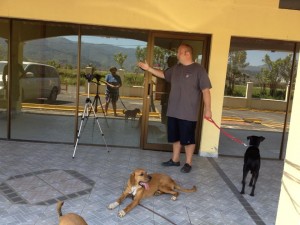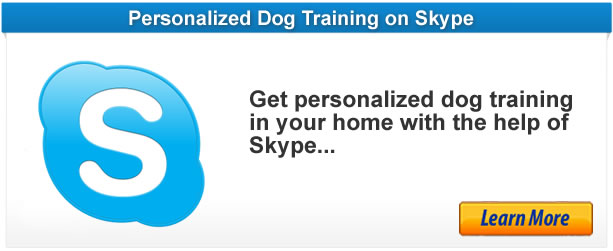I started working with dogs when I was a 14 year old kid chasing after my mentor, a great dog trainer. I continued working with dogs for years training for this trainer and others. While I honed my craft and learned an enormous amount from my mentor and other dog trainers it wasn’t until I was 25 that I started my own business.
At that point I was a college dropout, was working a graveyard job in a soul-crushing factory in order to pay the bills (at $12 an hour), was on the verge of bankruptcy, had a year old daughter and another on the way, and was crammed with this little family in a tiny little condo. Needless to say, I was at a crossroads. I could continue in my path or get this business going.
I had one thing going for me, though….
I had spent the previous year in relentless study of business principles. No, not the kind you learn going to college where professors teach you the theory behind how to grow your business.
Instead, I was learning from forums, information products, interviewing people who were successful, reading books and more. I wasn’t learning theory. I was learning real-life tactics that worked in the trenches and, above all, were affordable and easy enough for a broke, uneducated dog trainer to accomplish. My passion for figuring out how to build and grow a business was only rivaled to the passion I had as a nerdy 14 year old who wanted nothing more than to spend his day with man’s best friend.
It worked. That first year I cleared, after expenses, over 6 figures. Every year since then has seen growth to my business. We’re now a small business with a few employees and I have the freedom to travel the world with my family working on new dog projects that we’re passionate about.
Are we the perfect company? Absolutely not.
Am I smarter than other business owners? Nope. Just ask my wife how smart I am.
Do we make mistakes, sometimes fail to practice what we preach business-wise, and otherwise miss out on plenty of growth opportunities? You betcha. Our process is just like any other business owner’s and we’ve yet to reach ‘business nirvana’.
In spite of my failings and inadequacies do I have something I can teach you as a business owner? A big, fat ‘YES’.
While I don’t claim to be smarter, more successful, richer, or better than other business owners, since dropping out of college, I estimate I’ve since spent the equivalent of a bachelor’s degree at a fine University in products, coaching, consulting, and mentors. I absolutely know that since that first year in business until now I’ve gained a wealth of knowledge on real-world ways to grow a business and an income in ways that typically aren’t being done in our industry.
Not only have I amassed this business building info I’ve also found a way to systematize it in such a way that just about any business owner can start to see immediate AND long lasting growth from their business.
Maybe you want to travel the world like me. Maybe you just want more time off. Maybe you want more money for your kid’s college, to work with shelters, or to bulk up your shoe collection. Regardless on WHY you want growth in your business and more control over your income and time I’m confident I can help you with the HOW.
Introducing:
Undercover Income:
Finding Revenue Just Beneath the Surface Where You Never Thought to Look
When you’ve been in business, whether 6 months or 20 years, you create assets that can be leveraged to bring in more revenue, more clients, and more control over your time and income IF you know how to use those assets correctly.
ALL of us have assets in our business. They may be as intangible as ‘good will’ or ‘reputation’ or intellectual property or they may be something real like a customer list, facility, or employees. How you use those assets means the difference between a good living and growth.
Our Undercover Income System is designed to help you find and unlock those assets that you’d never thought of and see measurable, double-digit growth within months.
1- Define and create your Unique Selling Proposition (USP). If you don’t effectively differentiate yourself from your competitors why would they want to come to you in the first place, pay you higher fees, keep coming back, and recommending their friends?
Your USP is what turns you from a commodity into a valued professional. Your USP is essentially the message that you project to your prospective market. There is a science behind crafting a USP and masterful USPs have been the difference maker for companies for year. If you’ve thought that your prices should go up, that your time is more valuable than you are getting, that you don’t have the control over your time that you want, then you need to craft a brilliant USP.
2- Integrate your USP. As your USP is the message you give to your prospects it needs to be integrated into everything you do. It needs to be ingrained in your sales scripts, recorded messages, website, marketing material, greetings that your employees give, and everything else. This is more than just a snappy slogan; it’s the backbone of who you are and the problems you solve for your customers.
3- Database. The secret is out, the money is in the list. That ‘list’ is your current customers and your prospects. The name of the game here is lifetime value. What does a 10%+ raise mean if you can accomplish that every year? While database marketing is the quickest and most effective way to increase lifetime value of a client it is almost entirely ignored by people in our industry.
4- Internet marketing. Everyone wants to START with getting more traffic to their website. But think about it, if your systems aren’t honed it won’t help much to be driving in more traffic to your website. Let’s use the example of your business systems as a salesperson. If your salesperson doesn’t have great skills, does it pay to put him or her in front of a lot more people? Once you’ve accomplished the first three steps our system shows you how to drive lots more traffic to your site through simple, yet effective means. Instead of having a less than par salesperson you can have a ‘rainmaker’ style sales person working for you 24/7. We teach you how to avoid some of the fatal mistakes that actually turn visitors off when they get to your site and how to add elements to your site that are proven to get more leads, more interest, and more sales.
5- Copywriting. Make no mistake, folks. Whether you like it or not we’re in the sales business. Unless you want to try to do all the talking and all the selling to every single person who is interested in your company (good luck) then you need to learn the skills of copywriting. Effective copywriting magnetically attracts people who are the best match for your services while simultaneously repelling those who are most prone to being cheap, late, lazy, and a bad match for your services. The best copywriting is almost a license to ‘print currency’ as it serves to persuade people to open their wallets without you being present.
6- Effective advertising. If you want to create a mailer, print ad, postcard, newspaper spot, PPC campaign then you’d better know how to do it right. Not knowing how to craft the right ad is the quickest way to flush money down the toilet. If you can find the right ads, though, it’s almost like turning on the ‘client faucet’ on demand.
7- Joint Ventures. JV’s are the quickest way to inject much needed profits in the short term. In the long term, strong JV partners can feed clients into your pipeline in ways that are low cost or even free.
The bottom line is that this system puts the microscope on your business from a variety of different angles. The truth? Most business owners will get this full system and only have the time, ability, capacity to implement a handful of ideas. That’s okay, because consider what that can do for you. As the saying goes, ‘little hinges swing big doors’. What if just a few ideas lead to JUST one more client per month. Would that be valuable? For us we’re always thinking in those terms. Our average client is worth approximately $1700 so if we can get just ONE MORE CLIENT that translates to OVER $20,000 per year!
What about you? What does the extra client per month mean? What if it were two…or three? And what if you could not only learn how to get just a few more clients here or there but you were able to increase the amount of money those clients spent with you…and the amount of times they bought from you….and the amount of referrals they gave you?
I hope you’re seeing what I’m getting at. If I could help you make just a handful of changes that brought big earnings back into your bank account, what would that be worth to you?
For me, if I believed a system could bring me just 1 client per month and an extra $20,000 this year, and next, and next, and the one after, and so on I’d be calling my credit card company to see if I could up my limits. (Sigh, I know this isn’t a good business principle but I DID do this. One of the reasons I was next to bankrupt was because I had maxed out a card with $6500 so that I could get some internet training from some people I really respected. THAT took some sales ability to get my wife to sign off when I was just making $12 an hour. Luckily it paid off and that knowledge was a big part of how I saw that 6 figure payday my first year in business.)
When I do private consulting with business owners I have to charge a premium on my time.
For the first time, though, we’re going to be offering this system in a group setting. What that means is that for a small, limited group I’m going to be sharing a two-day intensive workshop that is guaranteed to take your business to the next level.
And I’m the guy who puts his money where his mouth is. I’ll let you come to the full two days, let you take the materials and workbooks, participate in all the discussions, learn from everyone at the workshop….
…and if you still don’t think you got your money’s worth I’ll give it all back. Yup. Every penny. If you don’t think my information is going to benefit you then I don’t WANT your money. And you can keep the training materials, your notes, and the contacts you made as an ‘I’m sorry’ gift.
Here’s how I see it, you’ve only got a few options:
1- You come to the workshop, hate it, get nothing, and you get your money back.
2- You come to the workshop, love it, yet decide to implement nothing. Boo to you on that one.
3- You come to the workshop, love it, start implementing just a few of the ideas and start seeing new clients, new revenue, and new control over your time as a result of what you learn.
I’ve taken all the risk for you. All I ask is that you come with an open mind, ready to learn, and go home with an attitude of being ready to implement.
Sound fair?
Price for two-day workshop to learn the Undercover Income System: $600
Early Bird Special: $450 before May 31, 2013
Hosted by: Jill Priest, near Toronto Canada
Location: Essa Valley Feed n’ Pet Centre, 4919 County Road 90, Essa, Ontario (about a 90-minute drive north from Pearson International Airport in Toronto). Depending on the number of attendees, a group van may be arranged. For Information, contact: Jill Priest, Time and Patience Dog Training, [email protected] or phone 416.487.4292.









Follow Us!
By FRESHCIGS electronic cigarette